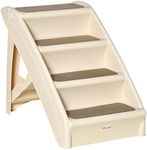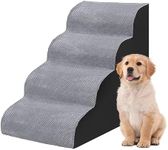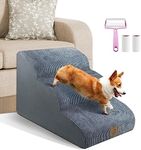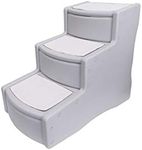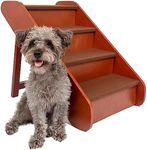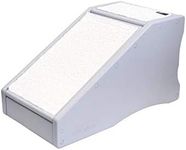Buying Guide for the Best Pet Stairs
When choosing pet stairs, it's important to consider the specific needs of your pet, such as their size, age, and any mobility issues they may have. Pet stairs can help your furry friend access higher places like beds or couches without straining themselves. The right set of stairs can make a significant difference in your pet's comfort and safety, so it's crucial to evaluate the key features before making a purchase.HeightHeight refers to how tall the pet stairs are from the ground to the top step. This is important because it needs to match the height of the furniture your pet needs to access. If the stairs are too short, your pet may still struggle to reach the desired spot, and if they are too tall, it could be intimidating or unsafe for them. Measure the height of the furniture and choose stairs that are slightly lower or equal to that height to ensure ease of use for your pet.
Step Depth and WidthStep depth and width determine how much space your pet has to place their paws on each step. This is crucial for stability and comfort, especially for larger pets or those with mobility issues. Narrow or shallow steps might be difficult for pets to navigate, while wider and deeper steps provide more room for secure footing. Consider your pet's size and choose stairs with steps that accommodate their paw size comfortably.
MaterialThe material of the pet stairs affects durability, weight, and comfort. Common materials include plastic, wood, and foam. Plastic is lightweight and easy to clean, making it suitable for small to medium pets. Wood is sturdy and can support larger pets but may be heavier to move. Foam stairs are soft and gentle on joints, ideal for older pets or those with arthritis. Consider your pet's needs and your home environment when selecting the material.
PortabilityPortability refers to how easy it is to move the pet stairs around your home. This is important if you plan to use the stairs in multiple locations or need to store them away when not in use. Lightweight materials like plastic or foldable designs enhance portability. If you need to frequently move the stairs, opt for a model that is easy to carry and store without compromising on stability.
Non-Slip SurfaceA non-slip surface on the steps is essential for your pet's safety, preventing them from slipping and potentially injuring themselves. This feature is particularly important for pets with mobility issues or those who are older. Look for stairs with textured surfaces or added grip materials like rubber or carpet to ensure your pet can climb up and down confidently and securely.
Weight CapacityWeight capacity indicates the maximum weight the pet stairs can safely support. This is crucial to ensure the stairs are sturdy enough for your pet. Exceeding the weight limit can lead to instability and potential accidents. Check your pet's weight and choose stairs that can comfortably support them, with some extra capacity for added safety.



